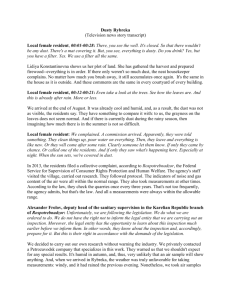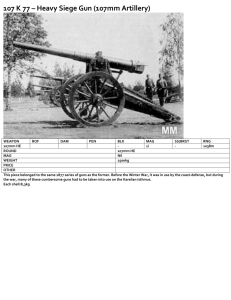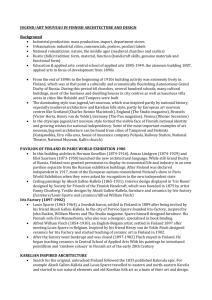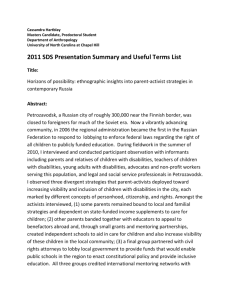Karelian Oikonymy: its Status, Problems and Prospects 1 N. N.
advertisement
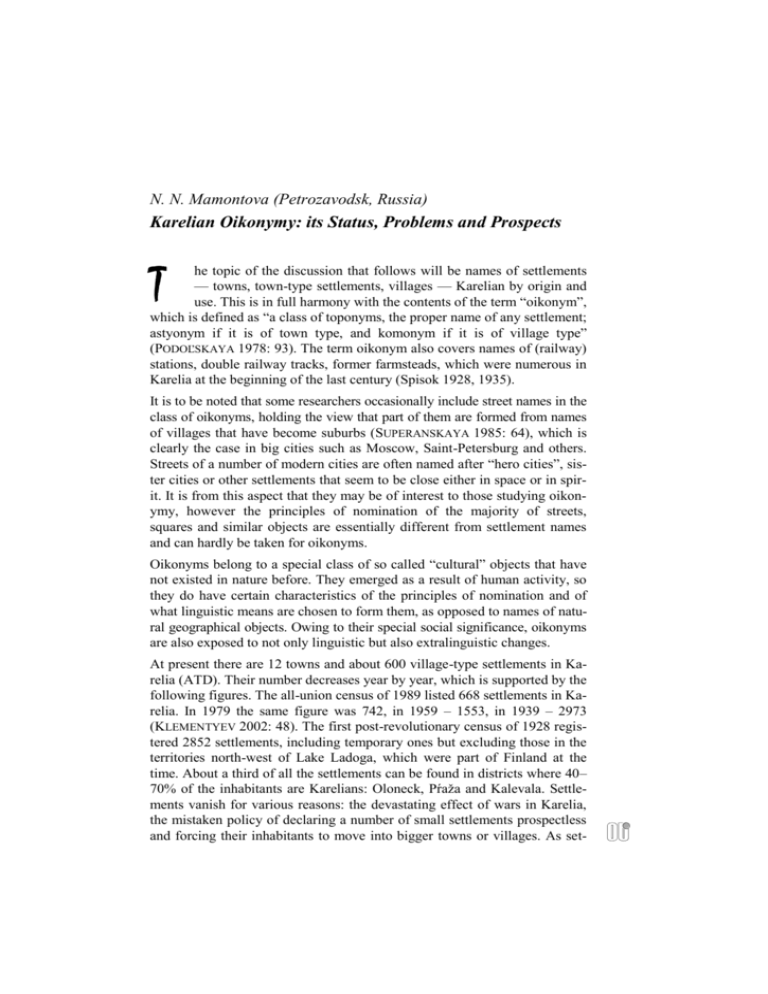
N. N. Mamontova (Petrozavodsk, Russia) Karelian Oikonymy: its Status, Problems and Prospects T he topic of the discussion that follows will be names of settlements — towns, town-type settlements, villages — Karelian by origin and use. This is in full harmony with the contents of the term “oikonym”, which is defined as “a class of toponyms, the proper name of any settlement; astyonym if it is of town type, and komonym if it is of village type” (PODOĽSKAYA 1978: 93). The term oikonym also covers names of (railway) stations, double railway tracks, former farmsteads, which were numerous in Karelia at the beginning of the last century (Spisok 1928, 1935). It is to be noted that some researchers occasionally include street names in the class of oikonyms, holding the view that part of them are formed from names of villages that have become suburbs (SUPERANSKAYA 1985: 64), which is clearly the case in big cities such as Moscow, Saint-Petersburg and others. Streets of a number of modern cities are often named after “hero cities”, sister cities or other settlements that seem to be close either in space or in spirit. It is from this aspect that they may be of interest to those studying oikonymy, however the principles of nomination of the majority of streets, squares and similar objects are essentially different from settlement names and can hardly be taken for oikonyms. Oikonyms belong to a special class of so called “cultural” objects that have not existed in nature before. They emerged as a result of human activity, so they do have certain characteristics of the principles of nomination and of what linguistic means are chosen to form them, as opposed to names of natural geographical objects. Owing to their special social significance, oikonyms are also exposed to not only linguistic but also extralinguistic changes. At present there are 12 towns and about 600 village-type settlements in Karelia (ATD). Their number decreases year by year, which is supported by the following figures. The all-union census of 1989 listed 668 settlements in Karelia. In 1979 the same figure was 742, in 1959 – 1553, in 1939 – 2973 (KLEMENTYEV 2002: 48). The first post-revolutionary census of 1928 registered 2852 settlements, including temporary ones but excluding those in the territories north-west of Lake Ladoga, which were part of Finland at the time. About a third of all the settlements can be found in districts where 40– 70% of the inhabitants are Karelians: Oloneck, Pŕaža and Kalevala. Settlements vanish for various reasons: the devastating effect of wars in Karelia, the mistaken policy of declaring a number of small settlements prospectless and forcing their inhabitants to move into bigger towns or villages. As set- 46 N. N. Mamontova tlements disappear, their names also drop out of memory, which means that the whole historical and cultural information included in them is lost. Apart from the sharp decline in the number of oikonyms in Karelia, there is one more tendency to be observed. This is directly related to the ethnopolitical situation and the problems of national and state-run development in Karelia in the Soviet and post-Soviet perestroika period. Figures of the 1989 census show that there were over 100 ethnic groups represented in Karelia, with 73,6% of Russians, 7% of Belorussians, 3,6% of Ukrainians, and other immigrants among them. The percentage of Baltic Finns in Karelia is estimated around 10%, within this figure Karelians represent 10%, Vepsians 0,8%, Finns 2,3%. The gradual assimilation of these peoples, especially Karelians and Vepsians, is going on, and this process is also reflected in the oikonymy of the area. As is well-known, the aborigines of Karelia are the Karelians, who also gave our Republic its name, and the Vepsians. They have been inhabiting the area from time immemorial, having pressed the Saami, the earlier aborigines, to the north. The Russians began to appropriate Karelia much later, from the 9th–10th c., peacefully mingling with the local population. This is convincingly evidenced by the oikonymy of Karelia as well as data taken from other field of scholarship. In the past, the territory occupied by the Karelians was undoubtedly much more extensive. It follows from this that oikonyms, Karelian by origin, can be found in areas where practically no Karelian population has remained, which applies to the regions along the White Sea, those north-northwest of Lake Onega and the Pudozh area. What should be added to these is the Ladoga region, which used to be the primordial habitat of the ancient Korela tribe – ancestors of present-day Karelians, completely inhabited today by immigrants not only from different parts of Karelia but also of the former Soviet Union. Karelian oikonymy has developed under the geographical, historical and ethnographic conditions peculiar to the area, similarly to other systems. The contact and interaction between linguistically related and unrelated ethnic groups (Saami, Vepsian, Finnish, Russian) have been instrumental to forming its present-day set. Thus, Karelian oikonymy, like several other categories of onomastic lexis, is multistratal, various by age and comprises not only names of purely Karelian origin but also items borrowed from other languages in different historical periods (e.g. the Karelian oikonyms Siidniemi, Suolužmägi can, in all probability, be traced back to Saami lexemes – cf. siid ’winter village’, su- Karelian Oikonymy: its Status, Problems and Prospects oluž ’small island’), whereas Besoučankülä, Matrossankülä are adaptations of the Russian names Бесовец and Матросы. It should be emphasised, however, that all the Karelian settlement names that have been used by Karelians so far are unofficial, as their Russian equivalents are considered to be the official ones. This phenomenon is rooted deeply in the past: since Karelia became part of the Russian state, all the names have been registered in official documents only in Russian, except for the first two post-revolutionary lists of settlements of the Karelian Autonomous Soviet Socialist Republic of 1928 and 1935. For the centuries, traditions of rendering local names in Russian have been settled: a nearly adequate interpretation (Ахвенламби – Ahvenlambi), partial or full translation (Святозеро – Pühäjärvi), reinterpretation (Соломенное – Salmi), simultaneous currency of two (or, less frequently, more than two) completely different names that have nothing to do with one another (Лояницы – Михайловское – Kuujärvi). All these ways of (phonetic, morphological and lexico-syntactic) adaptation of Karelian oikonyms to Russian are easy to point out by contrasting two existing, official and unofficial, names of one and the same object, i.e., a settlement in this case, which is applicable only to territories inhabited by Karelians today or in the not very remote past. For all the other regions, it is only the result of the complicated process of acquiring and adapting local Karelian (in a broader context: Baltic Finnic) names that can be observed. All this is amply evidenced in the census books and other documents of the 15th–16th centuries. The primary reason for administration in Karelia having been conducted in Russian (and, for some time, in Finnish from the 1920s) from the outset is that Karelian and Vepsian, the languages of the primordial inhabitants, were unwritten up to the 1920s–1930s or even longer, to the 90s of the 20th century. The national and administrational restructuring that began in the former Soviet Union after the revolution of 1917 deeply affected the historical fate of these peoples. When, in 1920, the Karelian Work Commune, later (1923) transformed into the Karelian Autonomous Soviet Socialist Republic, reorganised as the Karelo-Finn Soviet Socialist Republic in 1940 and made Karelian Autonomous SSR again in 1956, was formed, Finnish, which was fairly widespread in Northern Karelia, came to be used as a second official language, due to commercial and other links with Finland. It was, however, unintelligible to southern Karelians (Livonians and Lydians) and, to be added, Vepsians. In those years, the republic was governed mostly by “red” Finns (participants of the 1918 revolution in Finland). The principle of all the peoples enjoying equal rights, proclaimed by the Soviet power, was practically reduced to a policy of enforcement of Finnish. Priority was given to the use of Finnish in all walks of life, there was nothing done for the so- 47 N. N. Mamontova 48 cial and cultural development of the Karelians and Vepsians or for the creation of their literacy. Views concerning and approaches to written Karelian and Vepsian varied considerably in the 1920s–1930s, the early period of language planning, and later. These languages were labeled “uncultured” as opposed to the “cultured” official state languages, Russian and Finnish. Tuition in Karelian schools was translated either into Karelian or Finnish and Russian, although the Constitution of the Karelian ASSR acknowledged Russian, Finnish and Karelian as official languages. However, as early as in the Constitution of 1940, to be followed by two more in 1957 and 1978, official status was given only to Russian and Finnish (KLEMENTYEV 2002: 52–57). It was obviously under favourable conditions at a given point of history that the most complete lists of settlements of the Karelian ASSR, based on the censuses of 1926 and 1933, were published in 1928 and 1935 (Spisok 1928, 1935). Their specific feature was that the majority of oikonyms were printed in three languages: the official forms were given in Russian and Finnish, and, for the areas compactly inhabited by Karelians (and Vepsians), their Karelian (and Vepsian) versions were also registered in the Latin alphabet but, for some reason unknown, in low-case initials: (Russ.) Корби-наволок Перт-наволок Конец-остров Рая-сельга Сярги-лахта Вехку-сельга Сямозеро Реболы (Finn.) Korpiniemi Pirttiniemi Saarenpää Rajaselkä Särkilahti Vehkuselkä Säämäjärvi Repola (kar.) korbiniemi1 perťniemi šoarenpeä raiaselgü särgilahti vehkuselgä säämärvi reboľa (Нялмозеро) (Кончезеро) (Реболы) (Погранкондуши) (?Ссойла) (Вешкелицы) (Сямозеро) It is, undoubtedly, very important to list the names in their forms used by Karelians (and Vepsians) from time immemorial. On the other hand oikonyms, like any other types of geographical names, have the primary function of being used as addresses and, as such, must be absolutely precise, allowing for no variations. This would have required the fixation of one single correct form, because the variants in this case seemed to convey redundant information. To achieve the uniformity of form and use of Karelian (and Vepsian) oikonymy, time and qualified experts would have been needed, but the authorities opted for a different solution, which could have been simpler but far from being ideal: it was only traditional Russian oikonyms that were left to function, which is reflected in all the subsequent manuals on the territorial administration of Karelia. This attitude seems to be indicative of a cer1 Spelling of names is preserved in the forms as used in the Spisok. Karelian Oikonymy: its Status, Problems and Prospects tain neglect, of the national achievements of Karelians and Vepsians on the part of the Russians of our republic, coming mainly from the republic’s authorities. In Karelian oikonymy (toponymy in broader terms) the situation did not change even in the post-perestroika period, when, in 1991, the Karelian Autonomous Soviet Socialist Republic was renamed Republic of Karelia, in appreciation of the historical role of Karelians as the titular people. All this took place at a time when much was being done for the revival of national self-confidence of Karelians, Vepsians and Finns and the preservation of their languages and cultures. Such a situation, needless to say, was out of favour with the Karelians. When the Union of the Karelian people was having its first sessions, the call for the official reestablishment of Karelian place names was frequently sounded. More radical representatives of the Karelian public even demanded that all Russian names should be replaced with Karelian ones, if there were any. Of course, this came as a response to those in power not wishing to raise Karelian to the rank of a state language, still, such a solution to the problem would be mistaken and would lead to a kind of national confrontation as a consequence. The historically established system of Russian settlement names and names of other places served not only the Russian population of Karelia but also Russian speakers beyond its boundaries, and it would be highly unjust to reject Russian toponyms sanctioned by long traditions of use (MAMONTOVA 1988). With reference to the situation in Finland (cf. Finnish Turku and Swedish Åbo, Helsinki and Helsingfors), what could be suggested as and ideal way of dealing with the question would be the reinstatement of former Karelian (and Vepsian) names and their use parallel with the Russian ones. This applies to the oikonyms — names of settlements — first of all, since, being names of birth-places and dwelling places for individuals and owing to their social significance, they occupy a special place in the hearts and souls of people, who cannot be indifferent to what names they are surrounded by. Research into Karelian oikonymy has been a matter of interest for scholars. Thus the Finnish toponymyst VILJO NISSILÄ described Lydian settlement names in a special monograph (1967). He has also written studies on Karelian-Livian oikonyms derived from anthroponyms. A number of Karelian settlement names are analysed in other studies by the same scholar. There are several papers published in local collections, and the edition of the manuscript of “Karelian Oikonymy” has been finished (for further details see MAMONTOVA 1995). One of the most topical issues today is the edition and publication of a normative reference book of Karelian oikonyms that would include Karelian, Vepsian, Finnish and Russian forms. True, not everything is so simple. The question of awarding Karelian the status of an official language in Karelia and that of making it a uniform language for the Livians, Lydians and Kare- 49 N. N. Mamontova 50 lians proper have not been removed from the agenda. Depending on their solution, Karelian oikonyms will either have one literary form or will be presented in two dialects of Karelian: Karelian proper and Livian but not in Lydian. It seems to be more than obvious that the commission of terminology and orthography supervised by the State Committee of national policy of the Karelian Republic must pay special attention to all these questions or a new commission will have to be set up to regulate the use of Karelian settlement names. Oikonyms, like other categories of geographical names, are special relicts of the spiritual culture, history and languages of those nations which have created them. That is what makes their careful preservation and the regulation of their orthography, pronounciation and morphological features a task of primary importance. References ATD = Карельская АССР. Административно–территориальное деление (на 1 января 1998 г.). Петрозаводск, 1998. KLEMENTYEV, Y. I. (2002) Клементьев, Е. И. Карелия: штрихи к этнополитическому портрету (история и современность). In: Этнопанорама 2002/1, pp. 48–59. MAMONTOVA, N. N. (1988) Мамонтова, Н. Н. К вопросу о традициях в топонимии и о традиционных топонимах (на материале топонимии Карелии). In: Прибалтийско-финское языкознание. Вопросы лексикологии и грамматики. Петрозаводск, pр. 37–49. MAMONTOVA, N. N. (1991) Мамонтова, Н. Н. О структурных типах карельской ойконимии. Первичные и вторичные ойконимы. In: Прибалтийско-финское языкознание. Петрозаводск, pp. 46–57. MAMONTOVA, N. N. (1995) Мамонтова, Н. Н. Из истории изучения топонимии Карелии. In: Ономастика Карелии. Проблемы взаимодействия разноязычных ономастических систем. Петрозаводск, pp. 92–123. NISSILÄ, VILJO (1967) Die Dorfnamen des alten lüdischen Gebietes. MSJOu. 144. Helsinki. PODOĽSKAYA, N. V. (1978) Подольская, Н. В. Словарь русской ономастической терминологии. Москва. Spisok (1928) = Список населенных мест Карельской АССР (по материалам переписи 1926 года). Петрозаводск. Spisok (1935) = Список населенных мест Карельской АССР (по материалам переписи 1933 года). Петрозаводск. SUPERANSKAYA, A. V. (1985) Суперанская, А. В. Что такое топонимика? Москва.
